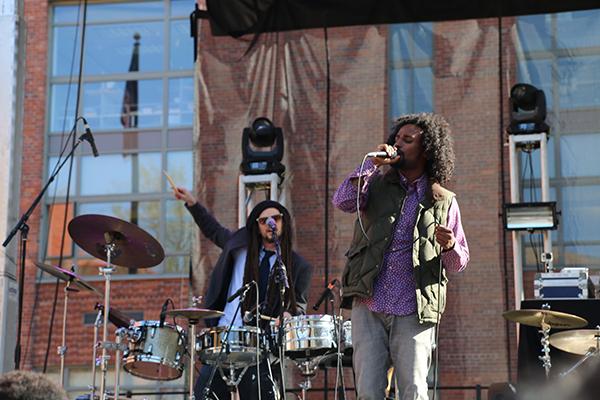
When Louie Diller trekked from the Mount Vernon Campus to his K Street apartment at 4 a.m. in the pouring rain two years ago, he questioned whether he had made the right choice by recording his music projects on GW’s suburban campus.
But today, the 2012 alumnus said that time on the Vern kickstarted what would become Holychild, a pop duo comprised of Diller and alumna Liz Nistico. Now based in Los Angeles, the band has signed to a major record label and is about to embark on a nationwide tour, opportunities Diller said wouldn’t have been possible if it weren’t for those late nights in the studio.
“A lot of the elements that I would produce at the Vern studio wound up making the final cut once we got those songs mastered. Those were the first few songs we released in 2012. Yeah, it’s crazy,” Diller said. “I started at the Vern.”
The recording studio, which opened to students in 2010, is tucked in the basement of West Hall across from the blackbox theater.
Aside from budget oversight from the Mount Vernon Campus Events Services, the studio is completely student-run. Sound engineers train younger interns before they graduate to keep a knowledgeable engineer in the space at all times.
Senior CJ Ballesteros is the current sound engineer at the studio, where he schedules recording sessions for students throughout the year.
In addition to ensuring that the equipment, including a full drum set, an electronic keyboard and amplifiers, is kept in good shape, Ballesteros also helps run the session and engineer recordings.
“Nine times out of 10, if we weren’t there, people would get into the studio and they would have no idea what any of the equipment was or how to use it, much less how to get an OK sound out of it,” Ballesteros said.
Because the studio space is free to use, it attracts student musicians who don’t have the money to rent out a professional space in the city, which can cost up to $90 an hour. Bands can use the studio as long as at least one member attends the University.
Oscar Diaz, a previous sound engineer who graduated last year, said the technology in the studio is as high-quality as most professional studios. Over the summer, GW added new microphones that cost about $2,000 a piece.
“We’ve been recording so many bands. Students don’t just come in there to record things to show to their friends, they come in there with ambition,” Diaz said. “So when we show the product to the administration, they give us more money.”
When students are looking to set up recording time, Diaz said he always recommends bringing some personal items to give the white-and-black room a creative touch and make it appear less bare.
DJ and GW student Haile Supreme, known for his reggae beats, has used the space along with Ballesteros’ own emo-rock band Soundtrack to Sleep, which recorded its first album in the Vern studio in the spring.
During the academic year, the frequency of use varies, depending on exam schedules and whether engineers are available. But Diaz said there were times when he’d stay in the studio for 20 to 30 hours a week, with sessions every day.
For students to fully record, mix and engineer songs, the process stretched out because Diaz said students don’t have the time to spend 10 to 12 hours in the studio each day like professional musicians.
Professionals can record all the vocals for an album in about two weeks, but students can take as long as a semester. And then the songs still have to be engineered.
“A lot of people come by and they only want to schedule one session and they want to record four songs and they expect it to come out really well in a three-hour period, but that’s just not enough time allotted to record,” Ballesteros said.
And while both Diller and Ballesteros couldn’t put an exact number on how many hours they spent in the Vern studio engineering, recording and mixing their tracks, Diller said those countless hours were the only way to accomplish his goals as a musician.
“I guess it’s just crazy when you believe in something and you have to go to great lengths in the beginning to see it through because no one else can see. It takes a lot of patience and a lot of perseverance,” Diller said.







